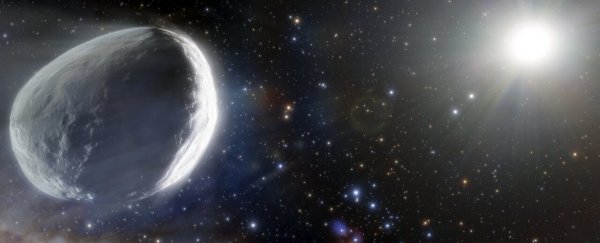The comet Bernardinelli-Bernstein (BB) – the largest our telescopes have ever spotted – is on a journey from the outer reaches of our Solar System that will see it flying relatively close to Saturn's orbit. Now, a new analysis of the data we've collected on BB has revealed something rather surprising.
Digging into readings logged by the Transient Exoplanet Survey Satellite (TESS) between 2018 and 2020, researchers have discovered that BB became active much earlier, and much farther out from the Sun, than was previously thought.
A comet becomes active when light from the Sun heats its icy surface, turning ice to vapor and releasing trapped dust and grit. The resulting haze, called a coma, can be useful for astronomers in working out exactly what a particular comet is made out of.
In the case of BB, it's still too far out for water to sublimate. Based on studies of comets at similar distances, it's likely that the emerging fog is driven instead by a slow release of carbon monoxide. Only one active comet has previously been directly observed at a greater distance from the Sun, and it was much smaller than BB.
"These observations are pushing the distances for active comets dramatically farther than we have previously known," says astronomer Tony Farnham, from the University of Maryland (UMD).
Some clever image layering was required to detect the coma around BB: the researchers had to combine multiple snapshots from TESS, which uses long, 28-day exposures, aligning the position of the comet each time to get a better look at it.
The size of the comet – some 100 kilometers or 62 miles across – and its distance from the Sun when it became active are both the main clues that carbon monoxide is present. In fact, based on what we know about carbon monoxide, BB was likely already producing a coma before it came within sight of our telescopes.
"We make the assumption that comet BB was probably active even farther out, but we just didn't see it before this," says Farnham.
"What we don't know yet is if there's some cut-off point where we can start to see these things in cold storage before they become active."
By repeating the image stacking technique on objects from the Kuiper belt, the researchers were able to confirm that their methods were indeed sound – and that the activity they'd spotted around BB wasn't just a blurring effect caused by putting several images on top of each other.
All these careful calculations are useful to astronomers in working out where individual comets have come from, and from there tracing back the history of our Solar System. That's certainly the case for BB, which continues to be of great interest to experts.
And, as our telescopes and probes get even more powerful, the comet discoveries are going to keep coming – whether that's finding the rarest of comet types out in space, or finding comets with chemical compositions that are a long way from the norm.
"This is just the beginning," says Farnham. "TESS is observing things that haven't been discovered yet, and this is kind of a test case of what we will be able to find."
"We have the potential of doing this a lot, once a comet is seen, going back through time in the images and finding them while they are at farther distances from the Sun."
The research has been published in the Planetary Science Journal.
